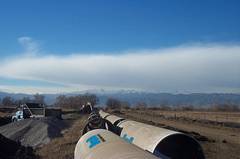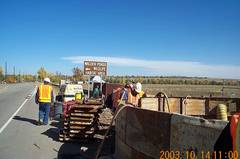Rocky Mountain High
The project will provide water resources to help offset the serious drought conditions in the area. When the project was conceived, stream flows in Colorado were the lowest they had been in nearly 100 years, and analysis of tree ring data suggests it could be the worst in 300-500 years. The drought has been so bad in recent years, the City adopted strict ordinances meant to preserve the water supply. In an effort to bring additional relief, the governor quickly acted to sign several bills aimed at assisting Coloradans with water supply issues. Many cities contacted the State Engineers Office regarding approval of a substitute water plan. Lafayette was one of those cities. “This project allowed a reliable source of high quality water,” stated Aaron Asquith, Principal with McLaughlin Rincon, Ltd. Of Denver.
Environmentally Friendly
The 24,000 feet of pipeline was located extensively in an area dedicated to open space and mountain parks and crossed through other municipalities. Negotiations and permitting with the City and County of Boulder mandated the construction be environmentally sensitive. The installation methods needed to address the concerns of constructing through wetlands with minimal disturbance. Designers needed to insure that there would be no long-term adverse effect on the wetlands. “It wasn’t as if we had an allowable leakage clause, we were allowed zero leakage and we needed a pipe that could accommodate those criteria,” Brad Dallam, P.E. with the City of Lafayette said. In addition, there were ten known prairie dog colonies and several bald eagle nests located along the project area; both had mitigation and protection clauses. To complicate matters, part of the line would be located within the railroad right-of-way, requiring additional permitting. Finally, there was a history of very hot soils in the area, making metallic piping options undesirable.
The tight tolerances of the joint systems, the history of leak-free installations and long life expectancy led to the specification of only fiberglass reinforced polymer mortar (FRPM) pipe. “We wanted a pipeline that would last for an extended period of time. Hobas has a good track record for maintenance and durability and had a very smooth interior that allowed for easy transport of sediments and small rocks in the diverted raw water,” stated Aaron.
Rapid Installation
In order to minimize the impact in the sensitive areas, and to relieve the stress on the water system due to drought conditions, the project was put on fast track. Final engineering design began in March of 2002; the job bid in multiple contracts in august of the same year. The permitting allowed only 4 ½ months for construction during the winter months; construction was substantially complete by February 2003. This was quite amazing considering the project included over 4.5 miles of pipe, intake and outfall structures and metering valves. Additionally, it was installed through a creek bed, wetlands, and across the treacherous countryside. None the less, the contractors that installed the majority of the piping project (AISA Civil of Broomfield, CO and BT Construction of Commerce City, CO) were able to meet the deadlines. In addition to expediting the design phase, Hobas could meet the tight delivery schedule. “We had a guarantee from Hobas that the pipe could be delivered on time. We even increased the footage we needed during construction by a few thousand feet and received that pipe within the original schedule. We had eight crews working on the project at once. Pipe was being installed at an incredible rate,” remarked Brad. Hobas customer service was constantly in touch with the installers to ensure that pipe was supplied timely. The quick assembly of the FRP joints and the light weight FRPM pipe section provided installation ease that helped in meeting the completion goal. “The installation was pretty easy,” stated Eric Koinzan, Project Manager with AISA.
“Very Satisfied”
FRPM has been used in this area for other types of installations including sliplining and above ground, although, very little had been installed by direct bury. Thus, the design engineers had very little prior experience with Hobas in this installation. BT and AISA, installers, were also first time users of the product. By the end of the project, those involved were seeing that Hobas is not your ordinary pipe supplier. Utilizing Hobas can provide assistance in many ways before, during and after installation. “The engineers at Hobas provided past cases and design calculations that significantly eased the permit requirements from the Union Pacific Railroad, and allowed us to minimize our impact in the sensitive habitat,” stated Aaron.
Contractor Friendly
The FRPM pipe offers an added benefit of being able to be repaired structurally in place. During the installation there were two localized areas that were damaged. “Those were fixed in place (a very nice feature especially when you send out a field rep to help our Contractor) and also tested just fine,” stated Aaron. A representative with AISA also had nice things to say about the product. “It tested 100% (leak-free) the first time – which was shocking given the project conditions,” remarked Eric.
The native soils on the projects ranged from very loose granular to very dense cemented sandstone (blows/foot ranged from 6-50). The embedment material chosen was ¾” minus crushed rock with a required installed density of 95% proctor. Even though the cover depth was rather shallow, ranging from 3-12 feet, a 72 psi stiffness pipe was chosen. The high stiffness design was specified to provide additional safety in the extremely variable soils. Luckily, the winter brought snow and the melt of this snow pack helped maintain the water supply. The City was graced with water from two alternated sources – Mother Nature and a little human intervention. The pipeline project was a huge success and everyone involved from the engineer and owner to the contractors were very satisfied with the product quality, ease of installation and the timely delivery.



